
Volume 10 Issue 3
May 2024


INSIDE THIS ISSUE
An Unfulfilled Promise? How a Historic Opportunity to Combat Gender-Based Violence Was Wasted
Multi-Party Litigation in Ireland: The Need for Reform
Commercial Activities in Outer Space: Anticipating Rebirth of Agency of Necessity
Separate but Equal: Family Law and the Failure of its Reforms in 21st Century Ireland by Luke Walsh
Paternity Leave: Scope for Reform? by Kate McGinnity
Multi-Party Litigation in Ireland: The Need for Reform by David O’Sullivan
An Unfulfilled Promise? How a Historic Opportunity to Combat Gender-Based Violence Was Wasted by Sarah Jones
Government Implementation of the Land Value Tax: Dead on Arrival? by Lawrence Valentine Murray
Economic and Social Rights in the EU: An Impediment to Equality? by Finn Doherty
The Importance of Valuing Care in Irish Law by Danielle Briody A Retrospective Analysis of the Proposed 40th Amendment by Ryan Hickey
Commercial Activities in Outer Space: Anticipating Rebirth of Agency of Necessity by Patricia O’Reilly
Ramadan in Gaza: Fasting for Faith, Fighting for Survival - Israel's Starvation Siege by Zoya Kherani
Rights
Year in Review: DU Law Society 2023-2024 by Louise Cullen
Year in Review: ELSA Trinity 2023-2024 by Mia Allen and Rhiannon
Farrell
Year in Review: Dublin University Journal of Criminology, Volume V by Doireann Minford
Year in Review: Trinity College Law
Volume XXVII by Alessandra
Table of Contents Letter from the Editor by Doireann Minford 3 1 | The Eagle Volume 10 Issue 3 Articles
Carbon Markets:
Criticism
Climate Solutions that Prioritise the Economy Over Ecology by Jenny Salmon Society Spotlight Year in Review: Trinity College Dublin's Free Legal Advice Centre (FLAC) 2023-2024
of Nature vs. Nurturing
A
of
by Sorcha Byrne and Zoya Kherani
Review,
O’Reilly Year in Review: The Eagle, Trinity College Law Gazette, Volume X by Ciara Hogan 5 6 8 11 13 15 18 19 22 24 25 29 31 32 34 35 36
Grossariu and Patricia
Senior Editorial Board
Editor in Chief: Doireann Minford
Deputy Editor: Jacob Hudson
Copy Editor: Ciara Hogan
Public Relations Officer: Amy Cox

Junior Editorial Board
Alex Coghlan
Aoife Doheny
Arielle Hillock
Chloé Asconi-Feldman
David O’Sullivan
Elena Hernandez
Jenny Salmon
John Lonergan
Kate McGinnity
Matthew Keeley
Michael Gormley
Nazar El-Basheir
Nóra Collins
Oisín Moore
Sarah Jones
Síofra O’Donoghue
Winta Solomon
Eagle: Trinity College Law Gazette https://eaglegazette.wordpress.com
The Eagle staff endeavour to practice ethical journalism and promote integrity in its work. The Senior Editorial Board reserves the right to publish only those articles that they regard as accurate and not injurious. We cannot guarantee that every article submitted to our publication will be published. All opinions expressed are those of the author and do not necessarily represent the views of the staff, students, or administration of Trinity College Dublin.
Design and layout: Doireann Minford
All photography is courtesy of Nathan Moore, SS Law and Political Science
Connect with Us
tcdeagle tcdeagle
The Eagle: Trinity Law Gazette
The
2 | The Eagle Volume 10 Issue 3
Letter from the Editor
A Chairde,
Reflecting on my year as Editor-in-Chief of The Eagle, I cannot adequately express how thankful I am for this opportunity. I am proud to have worked on three issues, overseen numerous blog posts, and collaborated with two wonderful societies
Firstly, I wish to thank our generous sponsors, Maples and Calder (Ireland) LLP, for their continued support over the past year. Their financial contributions keep the Gazette running and help us to provide you with accessible legal journalism yearround.
Next, I am deeply indebted to our Junior Editorial Board Ranging from first year to final year, and despite the workload of their degree, they have continued to provide insightful and detailed edits throughout all three issues Along with this, many of them have contributed to both the blog and the issues. I wish them all the best of luck in the future. Additionally, Aoife, Sarah, and David from the JEB will be working on the Senior Editorial Board next year I can rest assured that The Eagle is in safe hands owing to their experience and hard work in the past year
Without our authors, The Eagle would not exist For this issue, we had eleven excellent contributions ranging from topics on Irish law reform to commercial law in outer space. I am always interested in reading these articles from the beginning of the

Deputy Editor: Jacob Hudson
Copy Editor: Ciara Hogan

PRO: Amy Cox

editing process to the end and this issue in particular has some fascinating articles. It would be remiss of me not to mention Nathan Moore’s fantastic photography that he once agin provided for this issue
I also want to thank the members of the societies in Trinity who contributed to our year-in-review section Societies continue to be a highlight of student life in Trinity and it was my honour to highlight some of their work throughout the year.
Finally, the Senior Editorial Board has worked tirelessly on this issue as well as during the year I am lucky enough to consider Jacob, Ciara, and Amy as not just colleagues but life-long friends They are three intelligent, hard-working, and funny individuals who I shared both the SEB and a college course with Jacob and I started as first-year editorial board members and Ciara and Amy came slightly later. While our paths may diverge for now I do not doubt that they will cross over again in the future and I look forward to that immensely
I did not anticipate how sad I would be when my time at Trinity and The Eagle came to a close While I have no advice to offer academically, I will offer that if you are reading this and are still in college, savour your time there. Believe what they say, it goes by in a flash
Le gach dea-ghuí, Doireann Minford Editor-in-Chief
The Eagle: Trinity College

3 | The Eagle Volume 10 Issue 3


Separate but Equal: Family Law and the Failure of its Reforms in 21st Century Ireland
By Luke Walsh, JF Law and History
For most of us, when we think of family law in Ireland, we do not think of a modern system fit for a 21st-century state Over the last 70 years, Irish law has undergone a seismic change in its relationship with the family However, despite radical changes having been implemented to create a more equitable family law system in Ireland, there are huge discrepancies pertaining to the rights of those embroiled in the system. This article will aim to expose the blatant inequalities present within the Irish family law system today, and will outline how past reforms have been insufficient when it comes to tackling them.
Irish family law is not a branch of law known for being quick off the mark when it comes to reform The first statute to introduce legislative reforms in Irish family law since the founding of the State was The Status of Children Act 1987 This Act abolished the concept of “legitimacy” in Irish family law Legitimacy is an antiquated term used in family law to refer to one born out of wedlock. The Act also amended the Guardianship of Infants Act 1964 to allow an unmarried father to apply for guardianship for his child following an application to the courts. This legislative change marked a momentous step towards reforming a conservative and restrictive family law system in Ireland, which was designed to align with the views of the Catholic Church.
However, since the 1987 Act, progress has stagnated with regard to the rights of the unmarried father over his child. The 1986 Census recorded that only 9% of all families in the state were single-parent families, however, this number has grown exponentially since then. According to the 2022 Census, there are 186,487 one-parent mother families and 33,509 one-parent father families. However, since the turn of the millennium, only 1 major legal change has occurred regarding the rights of unmarried fathers
The Children and Family Relationships Act 2015 is a landmark piece of legislation, which deals with the
guardianship of children and the rights relating to parents of donor-reproduced children. Crucially for our case, it implemented new statutory rights for fathers of children born outside of marriage The legislation states that if a father can prove he was cohabiting with his partner for more than 12 months prior to the birth of their child, then he is automatically granted guardianship rights over the child upon its birth.
This legislation is overall a lot less favourable towards the unmarried father than the unmarried mother because if cohabitation cannot be proven by him, or did not occur, then the father of the child in question must petition the court for guardianship. In effect, this statute prevents unmarried fathers who do not meet the cohabitation requirement from having any formal legal input in the welfare of their child
It is reasonable that in some circumstances the natural father of a child should not necessarily be allowed contact. According to the findings of the Constitutional Review Board in 1996, “while [the board is] in favor of giving rights to the natural father…rights cannot be extended in absolute terms to natural fathers because, for instance, some children are born as a result of rape or casual sex.”While the first point made by the Board is entirely reasonable, the fact that the Board views fathers who have children begotten out of a casual sexual relationship to be on the same legal plane as a rapist shows how archaic the laws relating to unmarried fathers of children are in the Republic.
The 12-month cohabitation requirement for unmarried fathers to be given guardianship of their child only applies to couples who have cohabited for 12 months since the enactment of the legislation in January 2018. This means unmarried fathers who had children before the enactment of the law do not get automatic guardianship, even if they have cohabited with the mother of their child for the required 12 months Thus, the laws relating to the guardianship of children
5 | The Eagle Volume 10 Issue 3

by unmarried fathers are so varied and, in some cases, so out of date, that a need for further reform is blatantly visible.
Even in the supreme Irish legal text, the Constitution, we can see different treatment applied to married and unmarried couples Article 41 of the Constitution and its vague definition of the family is a prime example of this It is interesting to note that in the Republic we do not have a clear definition of what the “family unit” consists of. Commentators have speculated that the definition of “the family” in this case is the same as that of the Catholic Church, which helped to draft the constitution, namely, the father, the mother, and the child Despite courts no longer strictly adhering to this view of the family, Article 41 neglects to mention families of all types that exist in Ireland today.
The issue of parental primacy has always been a contentious topic in Irish family law. A prime example of this can be seen in the case of N v The HSE (Health Service Executive) This case involved the biological parents of a child, who had previously given up the child for adoption, requesting the return of the child from its proposed adoptive parents. The biological parents, who were unmarried at the birth of the child, married following their failure to obtain custody of the child in the High Court and this was recognised by the court when Fennelly J stated that it
seemed ‘reasonably clear’ that the couple had got married with the intention of improving their chances of getting custody. The legal view in the Irish state that is set out under Article 41 of the Irish constitution states that the marital home is that upon which the legal concept of the family is founded. The fact that the Irish state still considers the marital home and family to be the best safeguard of a child's welfare is ludicrous This tells us that the legislature's approach to legislating for single-parent families in the state is lacklustre and, in some cases, disregards the rights of a marginalised social group in the State.
The last 40 years have seen a huge rise in legislative reforms of family law in Ireland As illustrated in this article, these reforms have been insufficient in a general capacity. However, when we look at the case more broadly, the recent failure of the referendum to alter Article 41 of the Irish constitution tells us that reform is not something that the Irish public necessarily wants The idea that there exists a singular legal model for what the family is is something the Irish state must move from so that the law can apply to every type of family regardless of marital status. Recent changes seem to only serve some in Irish society and do not reflect the public's desire for a more equitable and flexible family law system fit for all men, women, and children.
Paternity Leave: Scope for Reform?
By Kate McGinnity, SF Law
Introduction
In 2016, legislation was introduced in Ireland which entitled fathers to paternity leave for the first time. The Paternity Leave and Benefit Act 2016 allows fathers of children up to six months old to take a leave period of two weeks from their employment, provided that they have given written notice no later than four weeks prior to the date on which they intend to begin their period of leave Additionally, the Act provides a payment of €230 per week to those who avail of the provision, provided that they fulfil the necessary PRSI requirements. Since the introduction of the Act, the paternity leave take-up rate has remained at approximately 50 per cent. The duration of the leave and the value of the benefit could be to blame for this low rate, particularly when compared with the policies of other jurisdictions
The Benefit
It is worth analysing the adequacy of €230 as a means of incentivising people to take paternity leave. The average weekly earnings of an employee in Ireland in 2023 was €920. The disparity between the average wage and the paternity benefit is a potential deterrent for those eligible for the leave. Although employers are authorised to top-up the benefit to their usual wage, research shows that this is a rare occurrence A study from the Irish Business and Employers Confederation (IBEC) in 2020 suggests that just 46 per cent of companies provide salary top-ups to employees availing of paternity leave. Taking paternity leave as a father in Ireland evidently places a huge financial burden on the household
6 | The Eagle Volume 10 Issue 3


The Treatment of Paternity Leave in Dispute Resolution
It is important to consider how disputes relating to paternity leave are dealt with and how this compares to the treatment of maternity leave. The same study from IBEC mentioned above found that 60 per cent of companies provide salary top-ups to employees availing of maternity leave From this data, it is clear that there is an inconsistency in employers’ treatment of paternity and maternity leave, even before disputes arise.
This inconsistency perpetuates the long-standing
preconception that men are restricted to their role in the workplace and the job of care-giving is reserved for the mother.
In Area Manager v Transport Company, the question arose as to whether it is discriminatory for an employer to top-up maternity leave and not paternity leave. The complainant, a new father, was denied topup to his salary while the respondent’s leave policy stated that new mothers in the workplace would receive their full salary for the duration of their maternity leave Adjudicator Joe Donnelly favoured the employer in finding that maternity leave cannot be equated with paternity leave and that “the special protection afforded to women in connection with pregnancy and maternity is embedded in both European and Irish law.” This decision is significant in that it confirms the acute distinction between paternity and maternity leave which is inherent in the law This inconsistency perpetuates the long-standing preconception that men are restricted to their role in the workplace and the job of care-giving is reserved for the mother. It is possible that if the Irish legal system granted the same level of protection to fathers as they do to mothers with regard to family leave, there would be a stronger desire among men to break out of their supposed traditional role, benefiting both the mother and the child, as well as themselves.
Paternity Leave in Sweden
While the Irish government and Irish employers struggle to tackle the issues of weak paternity benefit and gender inequality in the treatment of family leave, it appears that Sweden comparatively has succeeded in devising an effective parental leave policy. Through this policy, the Swedish government guarantees sixteen months of paid leave to parents. The first six months are divided equally between the mother and father, while the distribution of the
remaining ten months is to be decided by the parents themselves For 390 days out of the 480 days of this leave, parents are given nearly 80 per cent of their usual wages. Two-thirds of this amount is funded by a particular fee which is paid by employees. This fee is comparable to the Irish PRSI, in that it covers pensions and parental benefits among other functions The remainder is funded by taxes
The primary objective of the policy is to achieve gender equality in the home, as well as wage and participation equity in the workplace. Data from the World Economic Forum’s ‘Global Gender Gap Report 2016’ confirms the policy’s success In this report, Sweden is placed eleventh in the world for smallest gender gap in Economic Participation and Opportunity, while Ireland ranks forty-ninth. This is despite Ireland ranking only two places below Sweden in terms of overall gender gap. Ireland’s poor performance in this specific work-based subcategory could likely be attributed to its government’s less generous family leave policy when compared with that of Sweden The challenges that mothers face in the workplace, including the gender pay-gap and discrimination in both recruitment and promotion, could be significantly lessened if the government were to implement similar leave rights for both parents as they do in Sweden. Mothers would not be forced to forego a promising professional future for motherhood as the majority of their competitors in the workplace, both male and female, would be equally absent for a prolonged period of time.
Paternity Leave in Japan
In Japan, fathers are entitled to four weeks leave at 80 per cent of their salary In 2021, only 14 per cent of fathers availed of the leave This is remarkably low when compared with the success of the Swedish policy, where approximately 90 per cent of fathers took paternity leave. Japan has been improving paternity leave policy in order to encourage fathers to take on a more present role in the home and to move away from gender stereotypes in the labour force However, while the government persists in making these changes, a substantial increase in uptake rates is yet to be seen. This raises the debate as to whether it is a considerable change in social norms or further alteration in legislation that will solve this issue. Research carried out in Japan has found that taking paternity leave can hinder opportunities for work advancement The nature of the Japanese work culture is such that employees who prioritise work and undervalue their private lives are more likely to be promoted. It is worth considering therefore that Ireland’s low uptake rate could also be attributed to social issues rather than issues with the Paternity Leave and Benefit Act itself.
7 | The Eagle Volume 10 Issue 3

Conclusion
Through examining the Paternity Leave and Benefit Act 2016 and the Irish legal system’s approach to the Act, it can be established that an unduly low payment and an unjust treatment of paternity leave are significant flaws in this legislation. A higher benefit value is necessary to reduce the disparity between the current benefit and average wage rates This, along with more equal treatment of paternity leave when compared with maternity leave by both employers and adjudicators, could reduce the current reluctance among fathers to avail of paternity leave.
By comparing this legislation with the equivalent in Sweden, a notable reason for Ireland’s gender gap in the workforce is unveiled. Stronger family leave entitlements, such as shared parental leave, are crucial in closing this gender gap in order to achieve a reduction in employment based discrimination. This implementation would allow women to advance in demanding careers while simultaneously allowing men to spend more time developing greater bonds with their children. However, when analysing paternity leave in Japan, it becomes apparent that such a legal implementation must be paired with a shift in societal perceptions of gender to achieve such an increase in uptake rates of paternity leave
Multi-Party Litigation in Ireland: The Need for Reform
By David O’Sullivan, JF Law
Introduction
The term ‘Multi-party action’ (MPA) describes the “various types of legal mechanisms that enable a large group of people who have suffered similar harm to collectively bring a claim to court.”
In Ireland, there have been many cases in which multiple plaintiffs have taken actions that involve common questions of law and fact. From the army deafness claims of the 1990s to the recent pyrite and CervicalCheck scandals, this jurisdiction is no stranger to joined cases. Indeed, there is reason to believe that we will see an uptick in cases involving multiple litigants in the near future Take, for example, the looming threat of mass environmental harm caused by climate change and the prospect of mass torts arising from developing technologies. Nonetheless, there remains an uncertain approach to managing these cases from a legal perspective. A major Law Reform Commission (LRC) report from 2005 recognised the shortcomings in our management of mass litigation and argued in favour of the introduction of a formal multi-party action mechanism in Ireland. Despite this, the Oireachtas has not yet made any provision for its introduction.
The Objectives of Multi-Party Litigation
Multi-party actions are considered to have two distinct ‘goals’ – greater efficiency and greater representation In the first instance, multi-party actions can prove a more efficient, cost-effective method of litigating due to the aggregation of cases with common questions of law and fact. In the absence of an MPA mechanism in cases with numerous litigants, the litigation of ‘generic’ issues
must be repeated in each individual case This is arguably an inefficient use of the court’s time and leads to the multiplication of legal costs. Secondly, multi-party actions can increase potential plaintiffs’ access to justice due to their ability to address the distinct power imbalance often at play in cases of mass litigation This is because MPAs can create ‘economies of scale’ where the costs of bringing proceedings are spread across many plaintiffs. In this sense, MPAs allow for more people to be represented than would be otherwise.
The Irish Approach to Multi-Party Litigation
In the absence of a formal MPA mechanism, other methods have been utilised to manage cases involving multiple litigants in Ireland:
i. Public and Organisation Actions
In Public Actions, a public official may take an action on behalf of several individual litigants. An example of this is the right of the Attorney General to institute proceedings on behalf of the public for the assertion of their rights Organisation Actions may be utilised in a similar fashion, whereby an organisation which is deemed to have a sufficient interest in a specified area may institute proceedings on behalf of a large group of people.
Both of these mechanisms offer a limited route to collective action in specified circumstances, but they are far from a complete solution A clear problem is the fact that prospective plaintiffs who wish to take a collective action are dependent on the ‘whim’ of either a public official or a relevant organisation. This dependency on third-party approval is a clear barrier to justice for potential litigants, as is the fact that
8 | The Eagle Volume 10 Issue 3



An Unfulfilled Promise? How a Historic Opportunity to Combat Gender-Based Violence Was Wasted
By Sarah Jones, JS Law and History
On 6 February 2024, an agreement for the first-ever European Union (EU) directive on violence against women and domestic violence was reached between the Council of the European Union and the European Parliament This new law establishes minimum rules concerning the definition of specific criminal offenses and their associated penalties It also sets out the rights of victims and provides for their protection. Given that this is the first directive of its kind, many have welcomed it as a landmark achievement. However, for others, this anticipated milestone in the fight against gender-based violence is strongly diminished by one significant omission; namely, the offense of rape. This piece seeks to examine the achievements and shortcomings of this new directive by discussing issues relating to gender-based violence and, in particular, the crime of rape
EU Directive on Combating Violence Against Women
At the outset, to understand the potential impact of this directive, it is necessary to consider its broader legal context. EU law can be divided into two categories: primary law and secondary law. Directives belong to the latter category of secondary law. Rather than automatically becoming part of the domestic legal order, directives set out policies that Member States are under an obligation to implement The individual countries will then devise their own laws on how to accomplish these objectives Despite a degree of discretion afforded to Member States, the states are subject to a deadline by which they must enact national laws transposing these directives. Furthermore, the Commission may bring infringement proceedings where a country fails to implement a directive before the prescribed deadline.
Until now, domestic and gender-based violence has been dealt with in different ways throughout the Member States Consequently, this new directive ensures uniform standards apply throughout the Union Frances Fitzgerald, Fine Gael MEP for Dublin and the European Parliament’s lead negotiator for the
Directive cited crime prevention and certainty as the central objectives of this new legislation in an interview posted on her social media accounts.The Dublin MEP stated that, in ensuring that the same standards apply throughout all Member States, “a woman travelling around” can feel secure that the law will both “protect you and prosecute those who might attack you”. It is important to note that in this regard the law introduces an array of significant measures: including criminalizing forced marriage, genital mutilation, and, for the first time, cybercrimes such as cyberstalking, cyberflashing, and online incitement to violence. Furthermore, in an effort to prevent and combat violence against women and to ensure that victims of sexual violence have access to healthcare services, particularly services related to sexual and reproductive health rights (SRHR), the Directive stipulates that Member States must develop national action plans Thus, the Directive should be welcomed as a positive step in the harmonization of the prevention and criminalisation of different forms of gender-based violence, as well as in ensuring that victims have access to justice and support equally across the Member States.
[T]he Directive should be welcomed as a positive step in the harmonization of the prevention and criminalisation of different forms of gender-based violence
The Crime of Rape
However, the failure to include a cohesive and unified strategy to combat the crime of rape erodes this achievement by the European institutions. It is important to consider the various approaches EU Member States adopt in the criminalization of rape to understand why this has been perceived as a shortcoming In national legislation across the EU, the definition of rape has traditionally been based on the presumption of violence, threats, or the victim's inability to resist the aggression However, this
11 | The Eagle Volume 10 Issue 3


conception has been recognized as gravely flawed in light of recent rape cases and growing insights into the complexity of victims' reactions. This narrow understanding of rape, built on coercion and force, ignores the reality that the most prominent response among rape victims does not involve active physical resistance but rather a reaction characterized as "frozen fright" or "tonic immobility " Thus, it reduces complex reactions into an overly simplistic and often one-sided narrative, ignoring numerous other circumstances in which the victim cannot react. Examples of this include surprise aggression, sexual aggression resulting from power relations, or patterns of sexual aggression stemming from abusive relations Additionally, according to a 2016 Eurostat survey, victim-blaming remains a traditional and prevalent approach in rape cases, often endorsed, even if implicitly, by national courts. This involves the questioning of whether or not the victim’s behavior, attire, and sexual morals constitute provocation and thus reduce the perpetrator’s criminal liability.
Pertinently, there have been past attempts on an international scale to redress these varying standards. For instance, a significant turning point was the implementation of the Council of Europe Convention on Preventing and Combating Violence Against Women (the Istanbul Convention) in 2014. Its rape provisions drew heavily from the extensive body of case law accumulated by the European Court of Human Rights However, it is important to note that this is not part of EU law and hence, does not carry the same legal weight within all domestic legal systems. Nonetheless, 14 of the 21 EU nations that have ratified this convention have consequently aligned their legal frameworks with the relevant provisions, including those concerning rape This includes three EU Member States whose laws already recognized consent as an essential element of the offense. The premise of consent, in theory, provides that the victim's behavior and/or mental state should be the primary focus of trials. Notably, Ireland is currently amending its law governing rape, contained can in section 2 of the Criminal Law (Rape) Act 198, to further strengthen its consent-based definition. However, Estonia, France, Italy, Poland, and Romania, five parties to the Istanbul Convention, have not pursued any measures to include consent in their domestic definition of rape. Moreover, there are six EU countries which have not ratified the Istanbul Convention - Bulgaria, Czechia, Hungary, Latvia, Lithuania, and Slovakia
A Missed Opportunity?
In light of these inconsistent approaches, it is less surprising that the reactions to this directive have largely echoed disappointment and frustration. The
general feeling is that the Directive represents a missed opportunity to finally ensure a cohesive EUwide strategy for combating all forms of domestic and gender-based violence. A harmonized EU approach to rape which moves away from focusing on outdated ideas of violence would have been an important step in forcing these countries to amend their laws As aforementioned, under EU law, Member States are obliged to transpose the objectives of directives into their national legal orders, and failure to do so can result in sanctions. Significantly, together, the Commission and European Parliament advocated for various important proposals including a unified consent-based definition According to Amnesty International, this proposal, which would have created strong binding measures throughout the EU, was “needlessly shot down” by certain Member States. Frances Fitzgerald’s disdain for this omission is equally unambiguous. Fitzgerald “expressed disappointment and anger that the Council decided to omit provisions on the crime of rape based on the lack of consent” Fitzgerald maintained that the European Parliament and her MEP colleagues from “across the political spectrum” find the Council’s rejection “shameful”. She further stated that this decision was illustrative of “how far off a true union of equality we really are”. The Dublin Rape Crisis Centre (DRCC) has also voiced its concerns and has described the final product as “bitterly disappointing”, maintaining that the inclusion of rape within the Directive would have been “important for both legal and symbolic reasons”. The DRRC has consequently stated that the choice to exclude rape from the Directive is reflective of the “concerning belief that rape is an expendable provision”, that it “is not a political priority”, and that the “barriers to progress were greater than the courage of some Member States to overcome them”
According to commentators involved in the negotiating process, the failure to agree on a harmonious approach resulted from a political impasse following concerns raised by certain Member States on the definition of the crime of rape and whether the EU has the competency to legislate in this area Consequently, France and Germany, two of the most powerful Member States, blocked the definition of rape from being included in the Directive. Ireland, despite possessing comparatively strong legal protections governing domestic violence, also belongs to the opposing Member States While this impasse is disappointing, it is not entirely surprising. In a research paper from January 2024 by the European Parliamentary Research Service, the introduction of a unified EU approach to the definition of rape was described as “one of the major points of contention” between the Council and European Parliament. Given this sensitivity, it is perhaps understandable that a
12 | The Eagle Volume 10 Issue 3

political impasse occurred However, it is maintained that the current legal standards applied in various Member States are insufficient and therefore political sensitivity should not serve as a justification for failing to address this pressing issue. Ultimately, Fitzgerald has made clear that it is now up to the
European Parliament to decide whether to adopt the Directive which represents progress in many important areas of gender-based and domestic violence but, as she laments, excludes the “most heinous” gender-based crime.
Government Implementation of the Land Value Tax: Dead on Arrival?
By Lawrence Valentine Murray, JS Law
Introduction
Ireland has been in the midst of a housing crisis for well over a decade. The failure by successive governments to incentivise the construction of housing, the mass purchase of property by vulture funds, and the failure to use swathes of vacant land have all led to housing in Ireland being 94 per cent more expensive than the European average As of 2022, the ten biggest landlords in Ireland, all of which are corporations, owned over €7 5 billion worth of housing. The state has shown itself to be either incapable or unwilling to fix the issue as it holds €130 million worth of vacant sites in Dublin alone.
Given the dire situation, many have been led to believe that radical action is needed However, one of the less discussed and less radical solutions to the housing crisis is relatively simple. If properly implemented, a Land Value Tax (LVT) will have the effect of returning unused land to the market and penalising corporate landlords for their blatant opportunism
What is LVT?
Historical Background
In brief, LVT is a tax on the inherent value of land, i.e. the value that land holds separate from any improvements on it. Though the theory and practice of LVT predate Christ, it found its footing in modern economics through the writings of Henry George in the 1870s George identified how ‘land speculation’, or ‘sitting on land’ and allowing it to accumulate in value without using it, was a major contributor to the continuous boom-bust economic cycle. This practice led to a reduction in productivity as property accumulated with an increasingly small class of landholders This led to a large underclass of propertyless people who were forced into the rental market, increasing poverty and decreasing general well-being. Though LVT has seen some implementation over the past two centuries in
countries such as Taiwan and Australia, it has mostly fallen by the wayside in favour of more direct forms of taxation.
Practical Application
Several methods of calculating the unimproved or undeveloped value of land exist Commonly, it is either self-evaluated by the land owner or determined by the State through comparison with nearby unimproved/vacant plots, accounting for any notable differences (quality, size, etc).
LVT is the only form of taxation that does not lead to a decrease in living standards or production. Modelling has shown LVT to be far more effective at redistributing wealth as land taxes paid by foreign and domestic landowners are redistributed to the domestic market, thereby improving domestic living standards. Additionally, LVT does not operate at odds with the operation of our tax system. We already recognise a host of regulations on private property that are often more onerous than a tax In addition, unlike a property tax, LVT only taxes the unimproved value of the land, which was not created by the owner but by society as a whole.
Theoretical Basis
The ideological basis for LVT is simple; one should be entitled to the fruits of their labour As one has ownership of their body, they also have ownership of what their person creates However, an entitlement does not arise to what one has not created. A person dying of thirst in the desert has no ‘entitlement’ to water. Only through labour can one gain anything and claim the title to and value of it. Land is not created but exists separate from human activity. You do not create the value that the land inherently possesses The unimproved value of land exists as a result of society’s existence and is created through community effort. As such, it is only fair that as you did not create this value, you give a proportion of it back to society.
13 | The Eagle Volume 10 Issue 3

Current Implementation
Through the Finance Bill 2021, the Oireachtas introduced the Residential Zoned Land Tax (RZLT) in 2021, which was intended to take effect on the 1st of February 2024. As of writing, its operation has been deferred to the 1st of February 2025.
The RZLT is calculated at three per cent of the market value of the land in question The tax will apply to all land zoned as residential that is also serviced. Land that is “serviced” refers to land which has sufficient access to infrastructure required for residential development (e.g. roads, paths, sewers, etc). Residentially zoned land already liable for Local Property Tax is excluded from RZLT However, owners of a residential property with gardens or yards over 0.4047 hectares are still required to register the property with Revenue for inclusion on the ‘RZLT map’, though they do not have to pay RZLT under the current legislation.
The Problems with RZLT
Unfortunately, RZLT is poorly thought through and unlikely to have the effect hoped for. LVT is an alternative to taxes that actively discourage productivity by penalising people for working. Implementing LVT as an addition to, and not a substitute for, other forms of taxation shows either a clear misunderstanding or blatant disregard for the reasoning behind it
While RZLT does not currently apply to residential property, the fact that residences exceeding a certain size are required to register their property is an indicator of the likely intention to extend the tax in the future This would fall heavily on an already struggling class of homeowners while being of little benefit to renters and others seeking housing The owner of a hypothetical plot worth €40,000 unimproved would pay an additional €1,200 a year. This is no small sum for someone who is already subject to direct tax liabilities, such as PAYE, PRSI, and USC
While this is potentially crippling for many small landowners and landlords, it will do little to reduce land speculation or financially assist renters. Three
per cent is a paltry sum to a multinational vulture fund, especially given that the value of property in Ireland continues to increase rapidly. In addition, the failure to remove or decrease the rates of other taxes means renters are still subject to the same financial burdens without any further assistance being provided
While this is potentially crippling for many small landowners and landlords, it will do little to reduce land speculation or financially assist renters ...
The exclusion of derelict buildings from RZLT is completely at odds with the basic idea behind LVT; efficient land usage.
The exclusion of derelict buildings from RZLT is completely at odds with the basic idea behind LVT; efficient land usage It seems a bizarre choice to exclude a large amount of unused land from a tax that actively encourages efficient land usage
Conclusion
LVT is arguably the only tax that can truly be described as progressive or fair. It ensures that one does not get to benefit from unearned labour while also respecting private property rights It ensures it is more advantageous for owners to sell land to people who will make the most productive use of it rather than hoarding land. While the State seems to have recognised the benefits of LVT, it has, as with most things, implemented it in a poor and inefficient manner In its current form, RZLT will, at best, have a minimal impact on land speculation and inefficient land usage At worst, it will be yet another expense that citizens will be obligated to pay while seeing little, if any, tangible benefit in return.
14 | The Eagle Volume 10 Issue 3

Economic and Social Rights in the EU: An Impediment to Equality?
By Finn Doherty, JS Law
Introduction
Economic and Social Rights (ESRs) are often regarded as an important means of tackling socioeconomic inequality by fostering social inclusion and protecting the interests of marginalised communities However, this article will examine the role of ESRs in the jurisprudence of the Court of Justice of the European Union (CJEU) and examine whether ESRs adequately tackle socio-economic inequality in the EU. ESRs are rights which are traditionally considered ‘positive’, in that they place an obligation on the state to take actions to benefit rights-holders, often involving the assumption of a financial burden on the state. Examples of ESRs are the rights to social security, to education, or to housing, which are seen in many contemporary welfare states Part I of this article pursues a criticism of the international human rights framework in relation to inequality. Furthermore, part II examines how ESRs have been treated in CJEU jurisprudence, particularly in the context of actions taken by the EU. Finally, Part III applies the human rights and equality criticisms to the recent jurisprudence of the CJEU. It is concluded that the ESRs in CJEU jurisprudence fail to tackle inequality, particularly economic inequality.
General Criticisms
Moyn is perhaps the most vocal critic of the international human rights framework His central criticism is that the human rights framework inadequately tackles inequality Moyn suggests that human rights discourse has largely eclipsed discourse regarding social improvement. This criticism casts doubt upon the efficacy of the entire ESR framework, which seeks to tackle inequality, particularly economic inequality.
ESR litigation has been targeted by many critics who argue that these rights should not be justiciable (i.e. enforceable by courts) Langford outlines two key criticisms of ESR-based litigation: Firstly, there is a concern that judges will simply abdicate their obligations to enforce ESR The second criticism is
known as distributive inequality. The beneficiaries of ESR litigation are unlikely to be those who are most in need Only wealthier litigants, who can afford the costly legal fees associated with superior courts, can afford to pursue legal action to enforce their ESRs while those on the margins of society are denied access to justice as a result of their financial means, exacerbating inequality.
The human rights framework has been criticised as distracting from genuine discourse regarding societal inequality and social improvement while ESR litigation has come under scrutiny, particularly for the inequality exhibited in the distribution of resources. ESR litigation before the CJEU will now be examined in part II
ESR in CJEU Jurisprudence
Human rights are termed ‘fundamental rights’ in the EU system with three sources of EU fundamental rights law which the courts draw upon: The Charter of Fundamental Rights of the European Union (“Charter”), the principal source of EU fundamental rights law, The European Convention on Human Rights (ECHR) and the jurisprudence of its court, the ECtHR, which although not a part of the EU, is very persuasive to the CJEU, and finally the general principles of EU law developed by the CJEU from the 1970s onwards
The Charter contains several provisions such as the family’s right to economic and social protection (Art 33.1), housing assistance (Art 34.3), and healthcare for those who lack resources (Art 35). In a politically pragmatic move, the Charter states that its provisions contain both justiciable rights and non-justiciable principles with no indication of which provisions are rights, and which are principles. (Art 52.5).
It is often suggested that these principles are in fact the ESRs contained in the Charter This interpretation arguably gained traction during the 2008 financial crisis and the EU-wide austerity measures which
15 | The Eagle Volume 10 Issue 3


followed These measures were largely dictated by EU institutions to cash-strapped Member States in return for financial aid.
In Pringle v Ireland, a claim was brought challenging the legality of the European Stability Mechanism (“ESM”), which formed an aspect of the EU’s austerity package The CJEU rejected the claim that the Charter was applicable to the ESM, as the mechanism was not within the EU’s exclusive competence. This decision was viewed with much concern by academics and appeared to sharply limit the scope of EU law in the field of ESR litigation. Of particular concern was the fact that Pringle appeared to create a vacuum of responsibility where powerful intergovernmental forces could operate without oversight.
The decision in Pringle appears to have been tamed to some degree by subsequent decisions such as Ledra Advertising and Others v European Commission and European Central Bank which appears to allow claimants to sue for damages in cases where EU institutions adopt intergovernmental memoranda which the institutions themselves consider to be in violation of EU law. Even before Pringle, in DEB v Germany, the CJEU adapted a reference in relation to an austerity claim to explicitly take account of the Charter, indicating a fluctuating willingness to scrutinise EU policy and action
Applying Criticisms to ESRS in CJEU Jurisprudence
Moyn’s criticisms retain a significant amount of their force when applied to the jurisprudence of the CJEU. The Charter, by not distinguishing between rights and principles, is the source of much of the debate surrounding ESRs in the EU Discourse in civil society surrounding social improvement is fixated on whether the CJEU recognises a Charter provision as justiciable. This ultimately distracts from the quest to tackle inequality and serves to divert attention away from the legislative and executive arms of the EU.
The nature of ESR litigation before the CJEU is also a cause for concern Both judicial abdication and distributive inequality remain obstacles for litigants.
Pringle demonstrates that judicial abdication in matters surrounding ESRs is a concerning pattern within the EU legal framework Arguably, the CJEU
declined to enforce ESRs in Pringle as to do so would compromise the ESM, a political agreement deemed integral for the stability of Member States in financial crises. In both prior and subsequent cases, the CJEU appeared more willing to enforce ESRs, only adding to the legal uncertainty surrounding ESR litigation in the EU It appears that ESRs will only be enforced so long as the CJEU considers that doing so would not have a detrimental effect on the politics within the EU. This is problematic for two reasons: Firstly, this creates a lacuna of responsibility in the law where intergovernmental action is concerned. The ESM was not merely a standard intergovernmental agreement, it was one fundamentally related to membership of the EU and the Eurozone Secondly, the CJEU has left open the possibility of some ESRs being recognised as justiciable under the Charter. This encourages litigation in the area which simultaneously removes pressure from the EU legislature and executive to pursue social improvement while forcing the CJEU to consider inherently political arguments
Distributive inequality remains an issue in EU litigation. Even with the preliminary reference system, the CJEU is not a court of first instance and a litigant must have the requisite funds to bring a case in at least one national court, as well as to the CJEU. Although limited legal aid is available and costs may be recouped if the litigant wins their case, a system which requires an upfront investment in order to tackle inequality is inherently imbalanced against the most economically marginalised communities in our society.
Conclusion
If ESRs are little more than non-justiciable principles, then it is unhelpful for them to be included in the CJEU’s jurisprudence It would be desirable for the purposes of legal certainty if the Charter was amended to clarify the distinction between provisions that are rights and those consisting of principles. Moreover, the discourse surrounding inequality and social improvement would benefit from being expanded beyond the legalistic realm of the CJEU It would also place a higher onus on the legislative and executive branches of the EU to effect change, as money which is currently being spent by individual litigants could be better used lobbying for wider societal change. The current ESR framework within the EU is expanding, but one may question if this is a positive development
16 | The Eagle Volume 10 Issue 3


The Importance of Valuing Care in Irish Law
By Danielle Briody, JF Law and Political Science
Introduction
On the 8th of March 2024, the Irish Government sought to insert Article 42B into the Constitution, which would have recognised the “provision of care by members of a family to one another.” In theory, this provision could have supported informal care workers and the people in their care to receive the help that they need. However, it also could have delegated the duty of care to a sector that lacks the support it requires, without the involvement of an adequate formal care system. For the Irish electorate, the latter possibility seemed to be more likely and so, the referendum dramatically failed to yield a “Yes” vote The result highlighted the complexities and misunderstandings surrounding the concept of care in Irish society To remove a constitutional provision that delegated the “duties in the home” to Irish women, the Government arguably accentuated its own shortcomings in recognising care as a valued commodity in Irish society. The support that is currently provided to care in Ireland should be considered, as well as the importance of appreciating a sector that is relied on by so many.
Ireland’s Position on Care
The population of Ireland, like many countries in the world, is getting older, and the old-age dependency ratio is predicted to grow dramatically in the following decades. This means that as time goes on, the number of retirees depending on the working population for support will increase. As the population ages, the need for a supportive care system grows more urgent. Compared to other European Union (EU) countries, Ireland’s state involvement in care is relatively low. This places more pressure on informal caregivers, which is made evident by the fact that 1 in 8 Irish adults are family carers A community-based approach to care is generally preferred by those in receipt of it, and many people in care choose to be in the comfort of their own homes when it is possible, surrounded by people that they know. Unfortunately, the State’s support for this model has been underwhelming.
Most of the support provided to carers by the Irish State comes in the form of social welfare payments Caring is often a full-time job, and according to the 2022 Carer’s Allowance Survey, 73 per cent of carers carry out more than 50 hours of care work a week. The Carer’s Leave Act 2021 allows employees with domestic caring responsibilities to take unpaid leave for up to 104 consecutive weeks in order to provide full-time care to somebody in need. During this time, they can apply for the Carer’s Benefit or the Carer’s Allowance. The Carer’s Benefit is applicable to workers with sufficient PRSI contributions, whereas the Carer’s Allowance is a means-tested income support Similarly, single parents who are primary caregivers and who are employed, as well as married couples and civil partners with a spouse or partner who is a home carer, can receive a tax credit.
While these welfare payments are similar to those available in many comparable countries, there are few state supports in Ireland for home-care provisions. This means that workers are often pushed to provide full-time domestic care, a requirement that disproportionately affects women In 2018, more than 76 per cent of carer’s benefit recipients were women. Furthermore, during prime working years, between the ages of 30 and 64, there is an even larger inequality in the distribution of care work between men and women.
Irish Statutes and Policies Regarding Care
The Health Act 2007, as amended, is an important piece of legislation, which sets out how Irish law regulates care services. However, it has room for further improvement: it neglects important aspects of care work, excludes a definition for residential services, and adopts restrictive interpretations for different forms of care Furthermore, the Health Information and Quality Authority maintains that the Health Act follows a “one-size-fits-all” approach that does not encompass the diverse needs of different communities.
18 | The Eagle Volume 10 Issue 3

Sláintecare was implemented in 2019 as a roadmap to reforming care in Ireland It is working towards a universal health and social care system, in which people get “the right care, in the right place, at the right time.” Although Sláintecare aims to allow people with care needs to remain in their homes for as long as possible, the state does not provide any legal entitlements to homecare and access to such resources varies in different parts of the country However, the overall goal of Sláintecare has received widespread political support and can be seen as a foot in the right direction towards law reform in the area of care.
In some EU countries, the formal provision of respite care, day care centres, and home care can make informal care more manageable for family workers However, many social care services in Ireland are not formally regulated, including supported and assisted living, respite, hospice care, and live-in services. Fortunately, there have been recent advancements in the implementation of homecare regulations and statutory standards are expected to be developed soon.
In June 2019, the European Parliament implemented Directive 2019/1158 which gave workers the right to a minimum of 5 working days of carers’ leave with “adequate allowance” each year. Whilst this may not appear to be extremely radical, the directive also acknowledged that care needs are rising due to an ageing European population, and advised Member States to consider this in their care policies It also gave workers the right to request flexible and remote working arrangements and reduced working hours when needed in the context of care.
Conclusion
Despite increased support for care policies and recent developments, Ireland continues to fall behind many European countries In many cases, informal care is a labour of love. The decision to care for loved ones should not only be protected but it should also be recognised as the valuable sacrifice that it is. The provision of further state support would indirectly improve the quality of care itself and would be an important investment in the overall health and wellbeing of this country
A Retrospective Analysis of the Proposed 40th Amendment
By Ryan Hickey, JS Law

Introduction
On Friday the 8th of March 2024, the citizens of Ireland had the opportunity to cast their ballot with respect to two separate proposals to amend the Irish constitution. In response to the proposed 40th amendment, otherwise known as the ‘Care’ referendum, a staggering 73 93 per cent of the Irish people voted against the constitutional amendment Reflecting on this proposal, it is imperative to consider both the current wording of Article 41.2 and the wording of proposed Art 42B, along with the legal implications associated with such a provision. Upon doing so, it becomes glaringly apparent that more substantial legal reform needs to be taken to protect the position of carers in Ireland, with the view taken that the proposed amendment was problematic and offered no legal benefit to carers.
Article 41.2 and the proposed Amendment
A ‘yes’ vote for the 40th amendment would have had a dual effect. Firstly, it would have removed the wording of Article 41 2 of the Irish constitution, which recognises a woman’s life within the home and obliges the state to “endeavour” to economically support mothers who wish to remain at home.
Secondly, the introduction of Article 42B, an amendment to the constitution, which read, “The State recognises that the provision of care, by members of a family to one another by reason of the bonds that exist among them, gives to Society a support without which the common good cannot be achieved, and shall strive to support such provision ”
Critical Analysis of the 40th Amendment
Outdated Article 41.2
Kelly recognises that Article 41.2 is the single most dated provision in the constitution. There are 2 possible interpretations of this provision: (1) It was intended to acknowledge and value the work of women in the home, or (2) it supported the patriarchal assumption that women should stay in the home and be denied their right to work. In reality, it has had neither effect and has merely acted as a symbolic provision. In spite of this, Art 41.2 remains contentious due to its wording, and the proposed amendment offered an opportunity to satisfy the dominant view amongst policymakers and commentators that an amendment was desirable
19 | The Eagle Volume 10 Issue 3

Recognition of Carers
Provision of care policy in Ireland still places heavy reliance on informal care. Care in Ireland remains gendered as women tend to provide a large percentage of both unpaid and paid care. In the 2022 census, 6 per cent of the Irish population claimed to provide regular unpaid help/support to a family member, neighbour or friend with a long-term illness, health issue, or issue related to old age, or disability. In theory, the amendment offered an opportunity to constitutionally recognise and protect the importance of carers in Irish society. However, the extent of that recognition and protection appeared problematic and is considered below
Absence of Sufficient Obligation
The state’s obligation under the proposed Art 42B is to “strive to support” carers. This wording is quite similar to the obligation placed on the state under Article 41.2, which claims that the state “shall… endeavour to ensure” it is economically viable for mothers to stay at home However, as noted above, this provision has been wholly ineffective in requiring the state to provide any meaningful support to women with caring responsibilities. Indeed, the wording of both provisions are not identical and some regard the obligation under Art 42B to be stronger than that in Art 41.2. However, it must be stressed that there is no positive obligation on the state Instead, there is a conditional obligation that arguably would allow them to ‘opt-out’ of providing financial support to carers Therefore, it logically follows, that Art 42B would not have been interpreted as imposing any enforceable obligation on the state to support carers. Article 42B would not have had the effect of providing any new rights to people seeking support to provide care
“Family Care” only?
The proposed 40th amendment recognised the provision of care “by members of a family to one another by reason of the bonds that exist between them”. This wording implies that care provided outside of familial relationships would not receive constitutional protection from Art 42B Assumedly this provision would have done very little for those carers who provide care to non-family members, endorsing the status quo “where women predominantly bear the brunt of providing unpaid care”.
Furthermore, there was also an unspoken lingering danger that if the proposed 39th amendment was rejected in conjunction with the 40th amendment being passed, only families based on the institution of marriage would have been given the protection of Art 42B. Had this been the outcome, the restrictive definition of ‘family’ in Ireland would have been
applied to the provision of ‘care’ as provided by Art 42B This would have meant that not only would care have been restricted to family, but also that nonmarital families who provide care to one another would have not received the same protection.
Dual Effect of the 40th Amendment
As noted above, the 40th amendment proposed to both repeal Art 41 2 and introduce the new Art 42B Given the fact that these provisions differ in what they seek to do and who they seek to protect, it seems inappropriate that the only choice available to voters was to have one or the other. There was also a risk that many of the ‘yes’ votes were motivated by the individual's dislike toward the contentious Art 41.2 and not a genuine endorsement of the proposed Art 42B. Ultimately this approach was regrettable from a democratic perspective as it effectively limited the choice of voters.
Conclusion
Reflecting on the proposed 40th amendment it seems that the real choice was either to accept a partial change in the law now or reject the government's limited, symbolic reform in the hope that a better, more ambitious proposal is presented to the people. Regardless, the people of Ireland were ‘hedging a bet’ in the hopes that the law would improve. Art 41.2 is a provision of its time with no practical impact on the Irish people and society and should have no place in our Constitution However, at present, it offers no legal threat and remains a legally worthless provision. The law needs adaptation but this should occur based on an appropriate and legally valuable proposal from the government.
The proposed Article 42B offered no more than an opportunity to symbolically recognise the importance of the work carried out by carers in Ireland. Its apparent limited scope and lack of substantial obligation on the state would have likely rendered it an unenforceable provision. To effect meaningful change, a more legitimate step would be to either extend or introduce legislation in areas such as care allowances, respite care, adequate care facilities for adults and children, etc. On an international level, Ireland's failure to ratify the Optional Protocol to the UNCRPD has been criticised and although one could question the practical effect that the Protocol would actually have on the position of carers/people with disabilities in our domestic legal framework, a reconsideration of our position regarding this convention could prove a useful step in trying to ameliorate the position of carers in Ireland. Ultimately, Symbolic constitutional recognition offers no practical benefit to the 300,000 carers who need greater assistance from the state to effectively carry out their invaluable work
20 | The Eagle Volume 10 Issue 3


Commercial Activities in Outer Space: Anticipating Rebirth of Agency of Necessity
By Patricia O’Reilly, SS Law and French
Introduction
In this article, the historical doctrine of agency of necessity will be reappraised in light of the recent acceleration of commercial activities in outer space While once a curious anomaly of the law of agency, the doctrine is now considered to have been redundant by the speed, certainty, and convenience of modern communications. Yet, the far-reaching, unexplored nature of outer space means that agency of necessity is ripe for reappraisal in light of private commercial ventures in space.
What is Agency of Necessity?
Agency is a fiduciary relationship, based on consent between the principal and the agent. The principal consents that the agent should act on his behalf so as to affect his relations with third parties, and the agent consents to do so Agency of necessity departs from the basis of consent in the law of agency, in that an actor, without any consensual relationship of agency, seeks to be considered at law as an agent “of necessity”.
The doctrine is classically applied at sea; an individual, often a ship captain, is faced with an emergency that poses such an imminent threat to the property of the principal that there is insufficient time for the former to seek the latter’s authority or instructions In turn, this individual seeks to be classified as an agent of necessity, seeking the substantive reward for their actions Agency of necessity originated in early mercantile practices, specifically shipping law. In turn, its development in common law was largely confined to the maritime realm and bound to the conditions which rendered it operative. The deeply contextual nature of the doctrine is reflected by the criterion outlined by Slade LJ in The Choko Star, whereby the agent of necessity must show that it was not reasonably practicable to communicate with the principal to seek instructions The doctrine sits comfortably in a physical or geographical arena which is hazardous and unpredictable, and where breakdowns or delays in
communication are likely to occur. In the late 20th century, technological advancements developed to such an extent that difficulties in communication no longer came with the territory However, the renaissance of agency of necessity may be made possible by the emergence of a new, even more unknown commercial arena; outer space
Acceleration of Private Commercialised Activities in Outer Space
Outer space carries the same hazards and unpredictability that the seas once did, as well as an analogous prospect of profitability. Ventures by private actors in outer space are continuously accelerating, opening up this new commercial frontier On the 20th of February of this year, SpaceX launched and deployed its 16th satellite of 2024, with another 128 expected to be launched this year The revenues derived from the SpaceX projects are intended to further the more ambitious goal of the human colonisation of Mars. Morgan Stanley estimates that the broader space economy could be worth over $1 trillion by 2040. The rapid expansion of a new commercial sphere means that lawmakers will inevitably be forced to reconsider the doctrine of agency of necessity. By way of mere hypothetical, in the circumstances where the principal is on Earth and the agent of necessity is millions of miles away, whether on Mars, an asteroid mining rig or a private space station, it is anticipated that an urgent situation will present itself, whereby communication will be so inconvenient and uncertain that there will be insufficient time to seek the principal’s instructions, before acting on their behalf.
The rapid expansion of a new commercial sphere means that lawmakers will inevitably be forced to reconsider the doctrine of agency of necessity.
22 | The Eagle Volume 10 Issue 3


This connection between agency of necessity and new frontiers is not unfounded It has been held that the doctrine can and will be applied to meet the needs of expanding commercial practices. McCardie J opined in Prager v Blatspiel, Stamp and Heacock Ltd, “judges should expand the common law to meet the needs of expanding society, and expand the doctrine of agency of necessity without clearly defining the limits, if any, of its expansion” Therefore, the assertion that commercial activities in outer space will necessitate lawyers to revisit agency of necessity is justified by the understanding that the historical circumstances in which the doctrine once thrived, may present itself again in the form of commercial activities in outer space However, an alternative version of agency of necessity should be sought, one which responds to the broader intellectual, legal, and political shift away from individualistic 19th-century mercantile practices.
Is there Space for Altruism in Agency of Necessity?
The context in which agency of necessity originally arose in common law was one in which unregulated appropriation of resources beyond national jurisdiction was endorsed by the principle of ‘freedom of the high seas’. This enabled a level of commercially driven individualism which has been detrimental to both the environment and to socioeconomic objectives In response, international law has since sought to impose a more communitarian regime regarding the appropriation of resources in both the high seas and outer space. While this is the position of international policymakers, it does not necessarily translate to commercial interests. Any likelihood of effective international governance of outer space is likely to lag behind accelerated progress in outer space Accordingly, an interim approach which seeks to temper the individualised interests of private actors in commercial dealings should be pursued. This would entail a reevaluation of the presence of altruistic intention in commercial dealings.
Courts have been reluctant to accept altruism as a motivation giving rise to agency of necessity. Indeed, a distinction has been made at common law between ‘necessitous interventions’, and ‘true’ agency of necessity, the latter being favoured rather than the former. ‘True’ agency of necessity is akin to force
majeure, turning on the exceptional circumstances of emergency In contrast, necessitous interventions, typically argued on grounds of altruism, are frowned upon and seen by courts as akin to intermeddling in the principal’s affairs. In the prospect of a new frontier, an enhancement of the doctrine is proposed, whereby altruism would be rewarded beyond mere expressions of gratitude Centering altruism would temper the risk of a hyper-individualistic capitalistic regime in outer space.
In Nicholson v Chapman, a rescuer of a parcel of timber was held not to enjoy the equivalent rights of a maritime salvor Rather, his actions “should depend altogether for their reward upon the moral duty of gratitude” Beyond the context-specific rejection of the claim, in that it was on land rather than at sea, this demonstrates the long-standing presumption that altruism and commercial activities cannot coexist. Exacerbating this lack of space for altruism is the indeterminacy expressed by Lord Diplock in The Winson, “the law does not seem to have determined in this context what ensues where interests are manifold or motives mixed”. As evidenced by Sachs v Miklos, courts tend to perceive altruism as an active intention rather than an immediate reflex. Yet, in a situation where imminent action is required, it is more appropriate to consider whether the agent acted on an altruistic reflex, as opposed to on an intention.
Conclusion
With the advent of commercial activities in outer space, the context in which the doctrine of agency of necessity first arose is likely to repeat itself. We must then consider how lawmakers might approach this rebirth A conservative response would be to apply agency of necessity given the reoccurring factual premise, namely an unpredictable and hazardous environment, yet revert to the same restrictive application. However, there are grounds for a more meaningful evolution of the doctrine, which would entail a reappraisal of the value of altruism to commercial activities Human expansion into outer space merits this recentering of altruism, as human efforts into this new sphere should be infused with a degree of communitarianism, or collaboration, rather than be subject to monopolistic control by a small sect of dominant private actors.
23 | The Eagle Volume 10 Issue 3

Ramadan in Gaza: Fasting for Faith, Fighting for Survival - Israel's Starvation Siege
By Zoya Kherani, SF Law and Business
The prevailing starvation crisis in Gaza is a wellknown plight that has captured global attention. Israel's blockade of aid deliveries to the territory has resulted in dire famines for Palestinians, notably falling during the sacred month of Ramadan for Gaza's majority This man-made crisis raises profound questions about adherence to international humanitarian law and underscores allegations of war crimes against Israel. Specifically, Article 8(2)(b) (xxv) of the Rome Statute ICC Statute applicable to both international and non-international armed conflicts delineate the prohibition on intentionally starving civilians by obstructing essential supplies. Such actions, deemed egregious violations of International Criminal Law, necessitate examination through the lens of criminal intent and starvation as a method of warfare
According to World Health Organisation (WHO) Director-General Tedros Adhanom Ghebreyesus, the future of an entire generation is under serious threat. Israel's ongoing blockade has severely restricted the entry of aid trucks into Gaza by land. Additionally, Israel has prevented the passage of crucial supplies, including food, water, medicine, and other essentials, with only a minimal amount of aid allowed through the Rafah crossing from Egypt and Israel's Kerem Abu Salem (Kerem Shalom) crossing. Health authorities in Gaza have emphasised that the limited aid reaching the enclave is far from sufficient to meet the needs of its nearly 2 3 million inhabitants, particularly those in the northern region, where the spectre of famine looms.
According to the Integrated Food Security and Nature Phase Classification (IPC), a staggering 70 per cent of individuals residing in certain areas of northern Gaza are enduring the most severe form of food scarcity, surpassing the 20 per cent threshold typically indicative of famine conditions In total, approximately 1 1 million Palestinians in Gaza, representing around half of the population, are facing "catastrophic" shortages of food
According to the Geneva Convention IV, Israel bears the responsibility of guaranteeing access to food and medical supplies for the civilian population, as the occupying power in Gaza Even if Israel were not to be considered the occupying power, it would still be obligated to adhere to the customary prohibition against starving civilians as a tactic of warfare This prohibition is enshrined in Article 54 of Additional Protocol I, which includes facilitating the passage of essential items like food and water into besieged areas. Israel has previously acknowledged the relevance of this rule regarding its oversight of fuel and electricity deliveries to Gaza.
Moreover, Israel has openly acknowledged its deliberate starvation of the Palestinian population in order to deprive Hamas of sustenance Regardless of whether the primary objective is to coerce or starve out Hamas or to inflict suffering on Gaza's civilian population, such actions disregard the distinction between civilians and combatants, contravening Protocol I, Article 48 of the Fourth Geneva Convention. This interpretation underscores a nuanced understanding of legal principles, indicating a clear instance of employing starvation tactics as a method of warfare. By deliberately targeting the civilian populace, even in pursuit of military objectives, Israel's actions violate the fundamental principle of distinguishing between civilians and combatants, a cornerstone of international humanitarian law
This violation becomes especially evident when considering Article 54(3)(b) of Protocol I of the Fourth Geneva Convention, which explicitly precludes the use of starvation methods to coerce the movement of civilian populations. The deliberate deprivation of essential resources, such as food and water, with the aim of pressuring Hamas combatants, inevitably inflicts severe hardship on innocent civilians Such tactics not only fail to discriminate between combatants and non-combatants but also exacerbate the humanitarian crisis within Gaza,
24 | The Eagle Volume 10 Issue 3

compounding the suffering of an already vulnerable population
In essence, the deliberate targeting of civilians for the purpose of achieving military objectives constitutes a grave breach of humanitarian norms and underscores the urgent need for adherence to international law By disregarding the principles of proportionality and distinction, Israel's actions risk further destabilising the region and perpetuating cycles of violence and suffering. As the occupying power is obligated to ensure the provision of food and medical supplies to the population to the fullest extent possible, regardless of the means available
Even if we entertain the notion that Israel's control over Gaza has waned following its withdrawal, the obligations delineated in Article 59 of the Geneva Convention IV remain pertinent. This article mandates that if any segment of the population in an occupied territory lacks adequate supplies, the occupying power must consent to relief efforts on their behalf and facilitate them using all available means. Furthermore, under the same provision, all contracting parties are obliged to ensure the unhindered passage of relief supplies and guarantee their protection. It would be erroneous to suggest that an occupying power could sidestep these duties by retreating to the periphery of the occupied territory, effectively relinquishing governmental functions within that area, while still retaining control over the
supply of essential goods Such an interpretation poses a substantial moral hazard
Finally, Israel’s High Court of Justice has underscored the state's obligation under international humanitarian law to ensure that Gaza receives the necessary provisions to meet the essential humanitarian needs of its civilian population In a notable case, the Court commended the government for adequately supplying fuel and electricity to Gaza, affirming Israel's commitment to upholding the rules of warfare. It is troubling to observe that Israel is currently disregarding even the limited obligations set forth in its own domestic precedent
In conclusion, the dire starvation crisis gripping Gaza, particularly during the sacred month of Ramadan, sheds light on Israel's illegal blockade and its devastating consequences. The month of Ramadan traditionally embodies a spirit of empathy towards those less fortunate For many in Gaza, however, this sacred time of celebration has been marred by the effects of Israel's illegal occupation, depriving them of the joy they should rightfully experience. International Human Rights Law and Humanitarian Law outlines the guidelines that necessitate action both globally and by Israel. The atrocities that took place on October 7th do not justify the starvation of a civilian population under the disguise of attacking combatants There is an urgent need for justice and a renewed commitment to uphold the rights and dignity of all individuals by Israel and the global community.
Rights of Nature vs. Nurturing Carbon Markets: A Criticism of Climate Solutions that Prioritise the Economy Over Ecology
By Jenny Salmon, SS Law
“Throughout legal history, each successive extension of rights to some new entity has been, theretofore, a bit unthinkable.” - Professor
Christopher Stone
At UN Climate conferences, the concept of the rights of nature is something reserved for side-events, with more economically viable solutions to the climate crisis, like carbon markets, considered in actual negotiations. This piece looks at the work of Christopher Stone who campaigned for the rights of nature in 1972, to show that when it comes to climatecrisis solutions, a nature-centric approach is much more favourable than current approaches that favour
economic gain
In Professor Christopher Stone’s argument for the rights of nature, he draws a parallel between human moral development and the evolution of legal systems As humans developed and began to recognise the rights of particular groups, legal systems evolved to reflect this Despite the current climate crisis and its effect on humans, legal systems have not evolved to keep pace.
First, he looks at the rights of the child. Historically, children were viewed as property; fathers had the
25 | The Eagle Volume 10 Issue 3


power to modify the personal conditions of their children, to sell them, marry them off, divorce them, or have them adopted. A child was merely an object or a thing. The legal rights of a child have since been recognised and are constantly expanding and evolving. This evolution of rights is beginning to include environmental rights Notably, in 2023 the United Nations Committee on the Rights of the Child explicitly affirmed childrens’ right to a clean, healthy, and sustainable environment. A short number of years ago, this feat itself would have been, in the words of Christopher Stone, “a bit unthinkable”.
Professor Stone notes in his consideration of the rights of nature how each time there is a movement to confer rights onto some new “entity”, the proposal is “bound to sound odd or frightening or laughable”. In its infancy, the concept of giving rights to nature certainly was laughable, to the point of inspiring poetry.
Special Rapporteur to the UN on Climate, David Boyd, suggests that the case of Sierra Club v Morton was an instance where the American legal system was almost revolutionised in ascribing rights to nature. This case concerned the Mineral King Valley in the Sierra Nevada Mountains, an area of great natural beauty. Previously the site of extensive mining activity, it was then used almost exclusively for recreational purposes Its relative inaccessibility and lack of development preserved the valley’s quality as “a quasi-wilderness area”. However, in the late 1940s, the United States Forest Service considered Mineral King as a potential site for recreational development, inviting bids from private developers for the construction and operation of a ski resort and summer recreation area
By 1969, a development plan by Walt Disney Enterprises had been approved, including a $35 million complex of motels, restaurants, swimming pools, parking lots and structures to accommodate 14,000 visitors per day To provide access to the resort, the State of California proposed the construction of a new highway and high-voltage power line, both of which would traverse Sequoia National Park. This was challenged by Sierra Club who argued that the project should be halted and its permits cancelled. In response, the State government challenged Sierra Club’s standing to bring the lawsuit Initially, Sierra Club had enjoyed standing on the basis of a long history of environmental advocacy. However, this was challenged for the lack of evidence that the club’s members would be directly harmed by the proposed development. This was appealed to the American Supreme Court.
Professor Christopher Stone, aware of this case, and in the process of writing his article Should Trees Have Standing?, worked frantically to complete his hypothesis before sending it off to Justice Douglas who fortuitously had agreed to edit a special edition of the Southern California Law Review where Stone’s article would be published In Justice Douglas’ dissenting judgement of the Sierra Club v Morton case, he states that “[c]ontemporary public concern for protecting nature’s ecological equilibrium should lead to the conferral of standing upon environmental objects to sue for their own preservation”, and cites Stone’s article. Justice Douglas highlights points made by Stone about the legal personality of ships and corporations before concluding that “the voice of the inanimate object, therefore, should not be stilled.”
This was not a welcome stance. In the subsequent edition of the American Bar Association’s Journal, a poem appeared, “Reflections on the Dissent of Douglas J , in Sierra Club v Morton”:
“If Justice Douglas has his way –O come not that dreadful day –We'll be sued by lakes and hills Seeking a redress of ills. Great mountain peaks of name prestigious Will suddenly become litigious. Our brooks will babble in the courts, Seeking damages for torts How can I rest beneath a tree If it may soon be suing me?... ...Ah! But vengeance will be sweet, Since this must be a two-way street. I'll promptly sue my neighbour's tree For shedding all its leaves on me ”
This extract from the poem is reflective of the fact that at the time, the concept of nature having rights of its own was a publicly mocked school of thought. This poem even inspired a spin-off poem in the case of Fisher v Lowe in Michigan’s Court of Appeals, where in lieu of a written judgement, the trial judges wrote a poem similar to that of Naff’s, concluding “Flora lovers though we three, we must uphold the court’s decree” that nature has no rights or standing in litigation.
Hence, it has been established that Stone was correct in finding that each successive extension of rights to some new entity has been “a bit unthinkable” In terms of the climate crisis, widespread and rapid changes in the atmosphere, ocean, cryosphere and biosphere have already left 3.3 to 3.6 billion people living in contexts that are highly vulnerable to climate change. Solutions to such a large-scale crisis will require innovation, which will include extending
26 | The Eagle Volume 10 Issue 3

rights to new entities and moving towards including environmental rights in constitutions and civil codes However, nature is not as profitable as another entity: carbon.
Capitalist economics suggest that the man-made climate crisis can have a man-made solution: commodifying carbon This commodification began in 1997 when 37 industrialised states and the European Community agreed on the Kyoto Protocol at the United Nations Framework Convention on Climate Change’s third Conference of Parties (COP). It assigned binding greenhouse gas emission reduction targets to industrialised countries and authorised the use of market mechanisms like emissions trading systems It was decided that because a ton of greenhouse gas emitted anywhere in the world has the same climate change consequences for everyone, a single global market would be an economically desirable outcome to incentivise emission reduction anywhere However, this approach has failed to recognise the fact that vulnerable communities who have historically contributed the least to current climate change are disproportionately affected by its consequences. Further, it fails to consider the rights of people or nature.
At COP28 this year, when talking about reaching netzero emissions, President of the EU Commission, Ursula van der Leyen said: “We all know to keep below 1 5° [of global warming] we need to cut global emissions, and there’s a way to cut emissions while fostering innovation and growth – put a price on carbon.”
Despite the fact that the EU has had an emissions trading scheme that has commodified carbon since
2003, emissions are higher than ever Still, in 2024, the Commission are selling us this idea that society can innovate a way out of crisis through emissions trading schemes. While there may be economic benefits to emissions trading schemes, focusing on emissions trading schemes in all areas of EU Environmental Policy has become problematic, particularly in the EU’s approach to agriculture – an area where one would assume nature should be at the fore.
In the EU Farm to Fork Strategy and the EU Green Deal, it is stated that farmers will be rewarded ‘for improved environmental and climate performance, including managing and storing carbon in the soil...’ Reward will also be given to ‘farming practices that remove CO2 from the atmosphere’. These are not nature-based solutions. These are examples of where carbon and its stock market are being nurtured at a cost to nature. Nature-based solutions, like organic farming, are unequivocally more effective at climate mitigation than practices that supposedly ‘remove CO2 from the atmosphere’
Commodifying carbon involved innovating to create an emissions trading system that was ‘unthinkable’ at its outset. It is time to extend rights to something significantly less ‘unthinkable’. This piece contends that rights, and thus standing, need to be afforded to nature The climate and biodiversity crisis needs to be addressed, and valuing carbon since 1997 has not worked.
Justice Douglas should have his way –O come now that fateful day

27 | The Eagle Volume 10 Issue 3


Year in Review: Trinity College Dublin's Free Legal Advice Centre (FLAC) 2023-2024
By Sorcha Byrne, Chairperson of FLAC and Zoya Kherani, PRO of FLAC
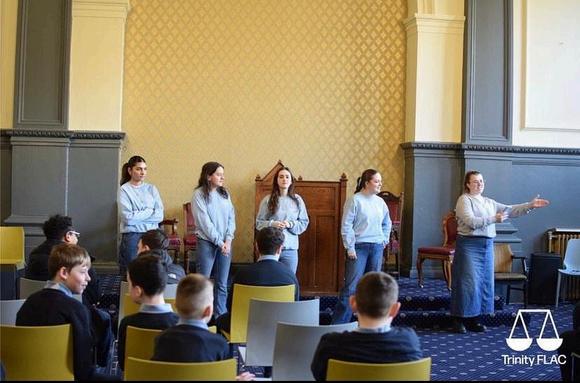
As we reflect on the past academic year, Trinity College Dublin's Free Legal Advice Centre (FLAC) stands as a beacon of legal activism and community engagement. Dedicated to providing free legal information, advice, and representation to those unable to afford or access such services, FLAC remains steadfast in its mission to promote and protect human rights, equal access to justice, and the rule of law
Throughout the year, FLAC continued to be a dynamic hub of legal activity, hosting a myriad of events and initiatives that addressed pressing social issues and contributed to greater legal awareness in society.
One notable collaboration was with the Trinity Access Program (TAP), which provided an incredible opportunity to ignite passion and curiosity in the legal field among young students Together, FLAC and TAP organised workshops and interactive lectures, offering insights into the legal profession and empowering students with knowledge about their rights. This collaboration not only enriched the educational experience of participating students but also fostered a sense of inclusivity and accessibility within the legal community.
Another significant event, "Protection of Human Rights in an Age of Digitalisation," brought together experts in cyber security and international law to discuss the evolving landscape of human rights in the digital era. Speakers such as Sofia Klymchuk, Christiane Ahlborn, and Samuel Elliott shared invaluable insights into the intersection of law and technology, highlighting the importance of safeguarding rights in an increasingly digital world. The event served as a platform for dialogue and collaboration, encouraging participants to critically engage with emerging legal challenges in the digital age.
FLAC's commitment to promoting social justice and legal advocacy was evident in a series of panel discussions and workshops held throughout the year. Events such as the "Empowerment Through Understanding: March 8th Referendum Information Session" and the collaborative panel discussion, with Trinity Psychsoc, on mental health within the justice system underscored FLAC's dedication to addressing critical issues and fostering meaningful dialogue within the community. These events not only provided attendees with valuable insights and information but also served as catalysts for social change and policy reform.
29 | The Eagle Volume 10 Issue 3


In addition to these events, FLAC hosted a range of talks and workshops on various legal topics, including disability rights, gender equality, and the Non-Fatal Offences Against the Person (Amendment)(Spiking) Bill 2023. These initiatives reflected FLAC's commitment to promoting legal awareness and empowering individuals to navigate complex legal issues effectively By providing accessible and informative resources, FLAC contributed to bridging the gap between legal knowledge and community empowerment, ultimately advancing the cause of social justice and equality.
FLAC's engagement extended beyond campus borders, as evidenced by initiatives like the toy collection and Christmas card-making for children in hospital, organised in partnership with Cancersoc as well as its fundraising efforts for National FLAC. These initiatives not only demonstrated FLAC's commitment to supporting vulnerable members of the community but also highlighted the importance of collective action and solidarity in promoting positive social change
Additionally, FLAC's involvement in raising awareness about the Green Paper on Disability Reform highlighted its commitment to advocating for marginalised communities and promoting social inclusion Trinity FLAC has also been committed this year to delivering tangible sustainability efforts through it’s “Say No to The Tote” Campaign and society-wide suitability survey. By providing platforms for discussion and education, FLAC played a crucial role in amplifying the voices of those affected by policy changes and advocating for their rights and dignity
FLAC also took the opportunity to recognize individuals who have made significant contributions to social justice and legal advocacy. Hosting esteemed guests like Ms. Justice Aileen Donnelly served as
moments of celebration and appreciation for those dedicated to advancing human rights and equality. These events not only honoured the achievements of remarkable individuals but also inspired others to continue their efforts in the pursuit of justice and equality for all members of society.
This year Trinity FLAC endeavoured to expand its reach and aims to both the law community and beyond which it successfully achieved through multiple interdisciplinary and intervarsity events. Additionally, the range of speakers both in experience and expertise made for an interesting and impactful series of discussions, with a strong emphasis on female representation and empowerment FLAC is excited to conclude such an amazing year with the final event in which Patricia Carey, the newly appointed chair of BeLonG To, will be appointed the Trinity FLAC Advocacy Award.
At the heart of FLAC's success lies the dedication and hard work of its committee members Individuals like Sorcha Byrne, Fiona Stenson, Jenny Salmon, Tara Brady, Zoya Kherani, Kyle Egan, Sophie Moutray, Ciara Murray, Johnny King, Sebastien Leymond, Daria Jerduch, Katie Loughney, Laura Halpenny and Miranda Marks ,played pivotal roles in organising events, conducting research projects, and fostering a culture of legal awareness and access to justice within the Trinity College Dublin community Their tireless efforts and commitment to their society and its work have been instrumental in advancing FLAC's mission and making a positive impact on Trinity College students and beyond.
Sorcha Byrne, Chair of Trinity FLAC, said that FLAC is both a community and a family of individuals who truly want to commit themselves to the promotion of and access to justice within our society today, and would encourage as many students who are dedicated to that goal to get involved in the future.
30 | The Eagle Volume 10 Issue 3

Year in Review: DU Law Society 2023-2024
By Louise Cullen, Secretary of DU Law Society
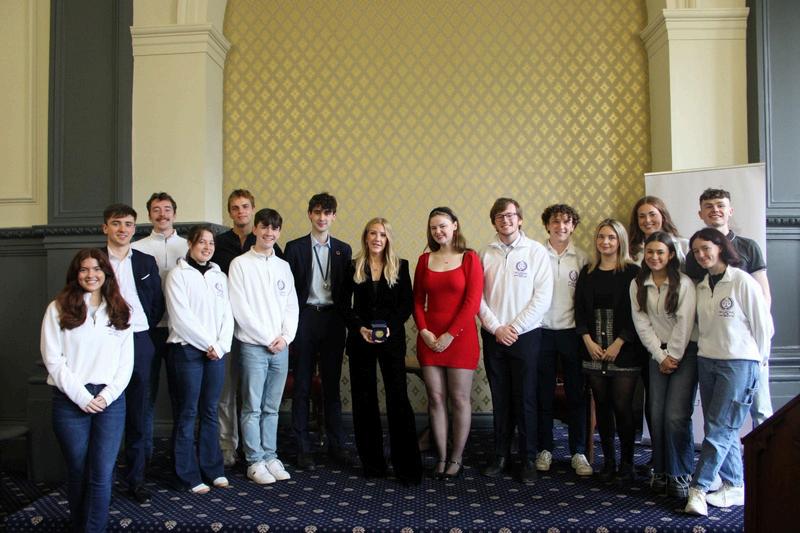
This year, LawSoc was delighted to celebrate its 90th anniversary. From beginning to end, it was a year marked by the dedication and passion of the committee members, on the Trinity campus and beyond.
LawSoc was delighted to welcome a range of guests to the Speaker Series, including Senator David Norris, Ellie Goulding, the actor Brian Cox, Lady Chief Justice Sue Carr, Lord Alan Sugar, Reni Eddo-Lodge, Maisie Peters, Ms Justice Aileen Donnelly, and Bernardine Evaristo. The Series saw fantastic engagement from students, and made regional and national news on a number of occasions.
More generally, LawSoc organised a panel discussion on housing with Deputy Eoin Ó Broin, Dr Rory Hearne, Senator Mary Fitzpatrick and Prof Rachel Walsh, as well as collaborating on several important debate topics with the Phil and the Hist (this house would NOT be a Trinity w*nker!)
The Trinity Women in Law (TWIL) subcommittee also had a jam-packed year. The legal mentorship programme continued, with a launch in the Museum Building featuring guest Noeline Blackwell. Other events included a presentation on the Magdalene
Laundries from Dr Mark Coen, a panel discussion with FLAC on the Spiking Bill 2023 and a successful release of the TWIL Report Volume III, which focused on reproductive health.
The 90th Session marked the second official year of the Diversity and Equality role As well as continuing the Diversity and Equality Summit and the Human Rights Debating Competition, a number of additional events were organised, including a lecture on the ICJ preliminary ruling against Israel, a paper reading with the Bram Stoker Club, and the Spotlight Series.
The Competitions team had a particularly successful year, running over six competitions and establishing the inaugural An Óráid competition. There was great enthusiasm for all competitions, but Junior Mock Trial in particular saw huge engagement: over 150 competitors took part, culminating in a Saltburnthemed final! There was also brilliant external representation in competitions, with teams reaching the finals and sometimes even winning in the Irish Times Debating Competition, the DLA Paper Sustainability Moot, and the UCC Intervarsity Mock Trial.
LawSoc also continued to provide career support to
31 | The Eagle Volume 10 Issue 3

our members Alongside the usual presentations from our sponsors, LawSoc organised a Masters Information evening with FLAC, a Breaking the Bar Panel Discussion on becoming a barrister, and an EU Careers event.
Of course, what would LawSoc be without social events? We continued to provide our members with lots of fun and lots of wine Highlights included the Cork Trip, the first year Pub Crawl, Swing Ball (in collaboration with Fashion Soc) and of course, Law Ball. Law Ball tickets were at their lowest price in five years and students were able to pay for these tickets in instalments, reflecting a commitment to making events as accessible as possible for all our members Some of LawSoc's proudest and most important achievements occurred off-campus.
This year, LawSoc's Charities Subcommittee fundraised on behalf of Barretstown, which organises specially designed programmes for children and families affected by serious illnesses LawSoc raised
over €14,000 for this fantastic cause, through events such as Charity Boxing, Lawst, Law Day and several pub quizzes.
The Outreach Programme, now in its third year, also continued to have a significant impact. The programme provides additional access and information about studying law to students from disadvantaged socioeconomic backgrounds In 202324, the Outreach Programme had over 50 student mentors - the highest level of engagement yet - with 12 schools and over 350 students taking part. A new Access to Law Day was introduced, running in addition to the annual Outreach Day
The LawSoc committee was delighted to conclude the year by being awarded Best Large Society at the annual CSC Awards. This could not have been achieved without the work of the wonderful committee members: thanks to Alex, Nathan, Alli, Anna G, Carla, Anna C, Ciara, Canice, James, Grace, Holly, Cormac, Jack, Graham, Val, Zoya, and Ruairi
Year in Review: ELSA Trinity 2023-2024
By Mia Allen, President of ELSA Trinity and Rhiannon Farrell, Secretary General of ELSA Trinity
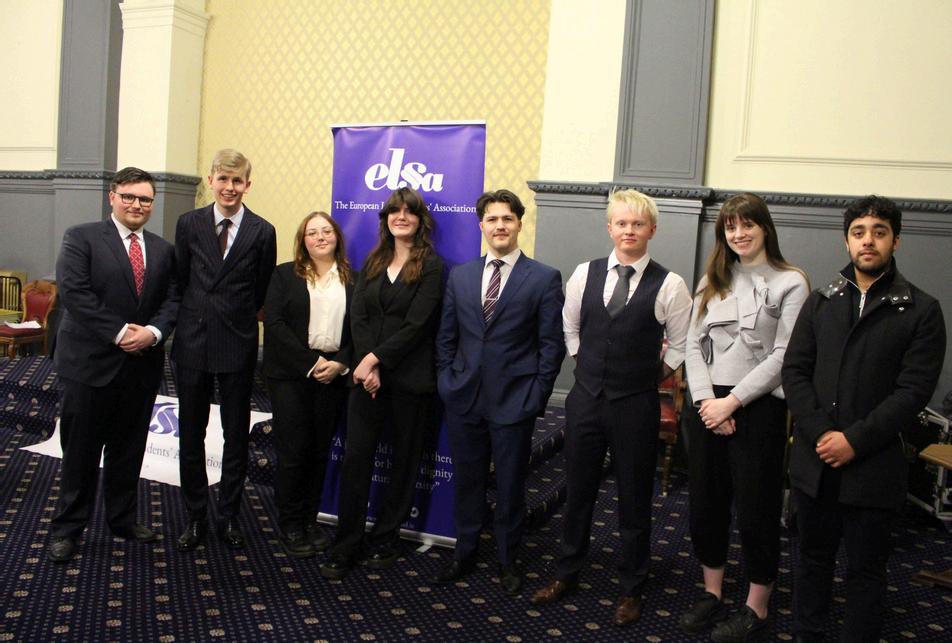
32 | The Eagle Volume 10 Issue 3


Trinity’s branch of the world’s largest non-profit association of law students has had an amazing year From redeveloping old competitions, to boosting our engagement, we are happy to say that ELSA is here to stay!
About Us
ELSA is a network of over 60,000 law students across the continent with the aim of creating socially responsible and internationally minded young lawyers. This network is an incredible tool for our members, with a diverse array of international traineeships and seasonal law school trips (SELS) organised and available to students Furthermore, the international nature of ELSA allows our members here in Trinity to build a network of like-minded students and contacts from across the globe.
Events
This year, ELSA Trinity held several educational and social events, with our annual Frances Kyle National Moot being the highlight of our year This year we ran the second edition of the competition, which is intended to be accessible to all levels of experience, with teams coming from all over Ireland to participate. Despite setbacks such as the riots in November causing us to postpone the competition, when we finally held it on the 25th of January in the GMB it was a huge success!
Another event that marked our success this year was the Helga Pedersen Moot Court Competition, the world’s largest human rights moot. A regional round was held on Trinity campus in collaboration with ELSA Ireland this February with over twenty teams coming from across Europe to participate It was an incredible experience and was a weekend that involved rigorous pleadings, but also some very enjoyable social events!
As a committee, we have tried to represent the diverse
network of ELSA in our events, and platform unique topics that expose students to different perspectives We held an incredible panel on Human Rights in the Context of Digitalisation in collaboration with FLAC with a specific focus on the war in Ukraine. Sofia Klymchuk was one of these speakers, an advisor to the Ministry of Digital Transformation in Ukraine, who worked in developing digital infrastructure used to resist the invasion by Russia We also welcomed Cord Meier-Klodt, the German Ambassador to Ireland, for a speaker event based upon the longstanding relationship between Ireland and Germany, held in collaboration with DU Germanic Society. A huge part of our work as ELSA representatives involves the promotion of alternative career paths in the law To this end, we organised a visit to Europe House for a discussion of the routes to working in the EU with TCD EU Careers. We have also planned a visit to the offices of Eurofound, giving our members an inside look at the institutions of the European Union
Of course, we held a number of fun social events to break up the monotony of day-to-day college life –with karaoke, language exchanges and coffee mornings all featuring! In Fresher’s Week, we held a pub quiz in the Pav Marquee in collaboration with DU Trampoline and DU Sailing which was a huge success One of the most enjoyable events held this year for committee and members alike was our Around the World Pub Quiz, held in collaboration with Erasmus Student Network TCD, where we discovered that nobody knew the Spanish word for meatballs.
Summary
The academic year of 2023/2024 has been ELSA Trinity’s best year yet! We are so proud of the work put in by our committee and the engagement from our wonderful members this year. We can’t wait to get started on our work for next year – watch this space!
33 | The Eagle Volume 10 Issue 3

Year in Review: Dublin University Journal of Criminology, Volume V
By Doireann Minford, Managing Editor of DUJC
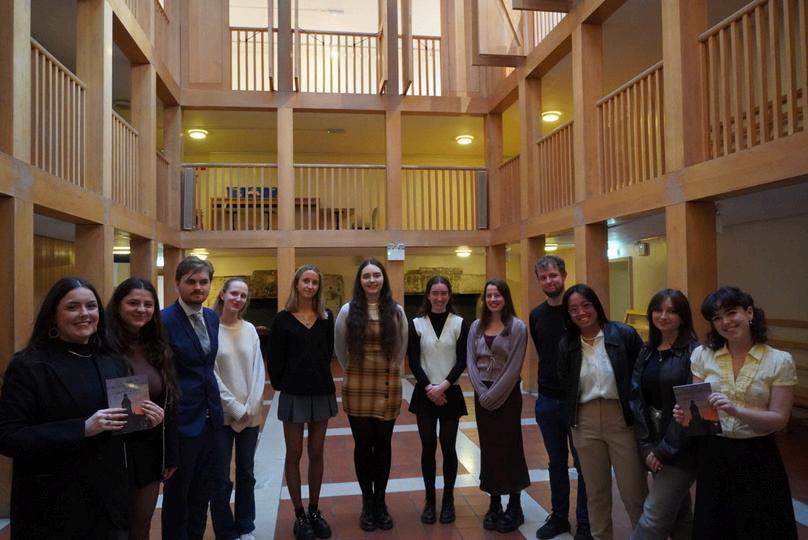
The Journal of Criminology entered its fifth year this year as Ireland’s only undergraduate criminology journal. This year, the journal expanded both its editorial board as well as the numerous events that were held over the year.
The editorial board this year included both undergraduate and postgraduate Trinity students and students from other universities on the island of Ireland This was done in an effort to expand both readership and authorship. In the end, this was incredibly successful with the journal receiving submissions from a multitude of institutions. The final product contained submissions from Trinity, University College Dublin and Maynooth University. Both myself and the Editor-in-Chief, Amy Cox were incredibly proud to publish articles on a range of issues from “the gendered pharmakon” to a comparative analysis of youth justice across New Zealand, Australia, and Canada
Our first event began with Amy interviewing our honorary President, Ivana Bacik The former Trinity lecturer and current Teachta Dála spoke in depth about the nature of criminology and the importance of its study. As the subject is no longer offered in Trinity’s Law School, it was interesting to hear of
both its intersection and distinction with law and other disciplines such as sociology and penology. Of particular note from this event was Deputy Bacik telling us of her experience as a student activist on Trinity’s Students’ Union and her efforts to provide abortion service information while the Eighth Amendment was still in place
In collaboration with Trinity Women in Law, we hosted a speaker event with Dr Mark Coen. Dr Coen gave an insightful talk about his research on Donnybrook’s Magdalene Laundry. His talk provided students with evidence of the lengths he had gone to in order to unearth Ireland’s past. For more information on this subject, I would recommend reading his book in collaboration with Katherine O’Donnell and Maeve O’Rourke entitled “A Dublin Magdalene Laundry: Donnybrook and Church-State Power in Ireland”
Finally, our launch encapsulated all the work completed by both the authors and the editorial board throughout the year We were lucky enough to have Kieran FitzGerald, former Garda Ombudsman Commissioner in to speak at the event. He spoke in depth about policing in Ireland and his time as Garda Ombudsman Commissioner. Afterwards, attendees
34 | The Eagle Volume 10 Issue 3

were invited to further discuss both policing and criminology with Mr Fitzgerald
The journal would not have come to fruition without firstly our authors. Secondly, our Senior, Junior and Copy Editors put in tireless work in both choosing and editing submissions It would be remiss not to thank our Design Editor, Channing Kehoe for her
mpressive work for the issue Finally, none of this would have been possible without Amy Cox, our Editor-in-Chief. Her intellect, hard work, and dedication to the journal are clearly evident in the success of the journal and the events she organised throughout the year. It is our hope that the journal continues to be as successful in the years to come
Year in Review: Trinity College Law Review, Volume XXVII
By Alessandra Grosariu and Patricia O’Reilly, Editors-in-Chief of TCLR
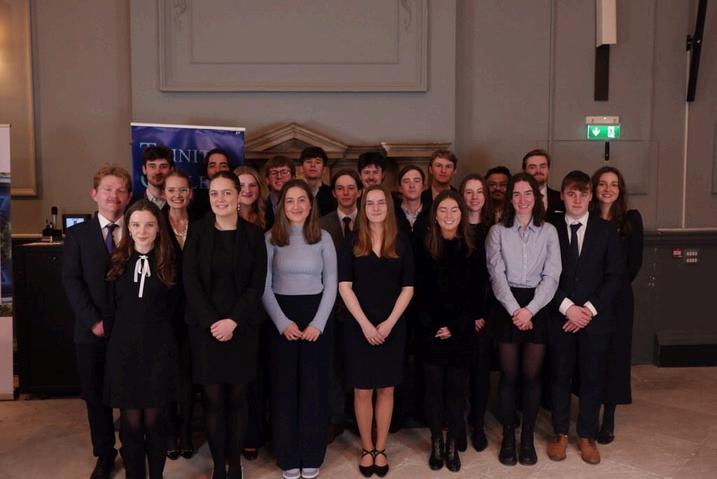
As Ireland’s oldest and leading student law journal, our mission is to provide a forum that encourages and facilitates writers to look beyond that which is seemingly set in stone TCLR aims to offer a platform which shapes academic moulds and ideas, dismantling the conventional, in order to advance our critical understanding and grasp of contemporary legal issues. In our daily activities, we aim to introduce undergraduate law students to legal academia - a sphere which may seem intimidating for those unacquainted
This year, we successfully ran two competitions, the Arthur Cox Alternative Perspectives Competition, which is open to non-law students at Trinity, and the Arthur Cox Secondary Schools Competition
Alternative Perspectives aims to foster true interdisciplinary analysis This year it was awarded to Sadbh Ní Dhúinn for her outstanding piece entitled, ‘Medieval Defamation: A World of Social Cohesion or Social Discord?’. The Arthur Cox Secondary Schools Competition is aimed at secondary school students who are interested in expanding their legal knowledge. This year, the winner was Muiris Ó Clochartaigh, who wrote a well-argued and informed piece, entitled ‘In the context of the current housing crisis, should the law allow the government to seize private property?’
As regards events, we initiated our activities this year with the successful revival of our Case Note Writing Event, instructed by Adam Elebert and Sam Walsh
35 | The Eagle Volume 10 Issue 3

Subsequently, we hosted an instalment of our Distinguished Speaker Series, entitled ‘Law and Emotion’, featuring Dr. John Stannard. In Hilary term, as part of a collaborative event Trinity FLAC and TCD Colloquium, in the context of the two highly topical referendums on women in the home and the provision of care by family members, we hosted an informative panel with speakers Dr James Rooney, Dr Mary McAuliffe and Rosemarie Hayden
The real work for us began in January, in processing, shortlisting and selecting articles for publication. We are truly grateful for the high-quality and large volume of submissions we received, which made our task both challenging and rewarding Each board member brought an informed, constructive and critical perspective to the process, bolstered by the atmosphere of collegiality at our annual ‘Editing Weekend.’ The selected articles (which will soon be going to print!) cover a wide range of pressing issues, each bringing something new to the table As we approach the end of the year, we look forward to
celebrating the hard work of both authors and editors at our annual Launch Night, which will feature a keynote address from honorary guest, former Chief Justice Frank Clarke.
While the production of a journal is fundamentally a team effort, Volume XXVII of Trinity College Law Review was only realised by the contributions made at an individual level We’d like to firstly thank our cohort of Junior Editorial Board Members, Orla Bates, Sarah Gonnord, Conor Heerey, Ben KieranGlennon, John Lonergan and Jack O’Sullivan. Further, we’d like to thank our Managing Editor, Ámhra Carey, and the members of our Senior Editorial Board, John Blundell, Sorcha Byrne, Chinmayanand Chivukula, Andrew Cunningham, Aoife Doheny, Jane McElwee, Síofra O'Donoghue, Liam O'Flanagan, Jane Prendergast, James Ryan, Eoin Ryan, James Turley, Sam Walsh and Madailein Watters for all the dedication and enthusiasm they put in throughout the year
Year in Review: The Eagle, Trinity College Law Gazette, Volume X
By Ciara Hogan, Copy Editor of The Eagle
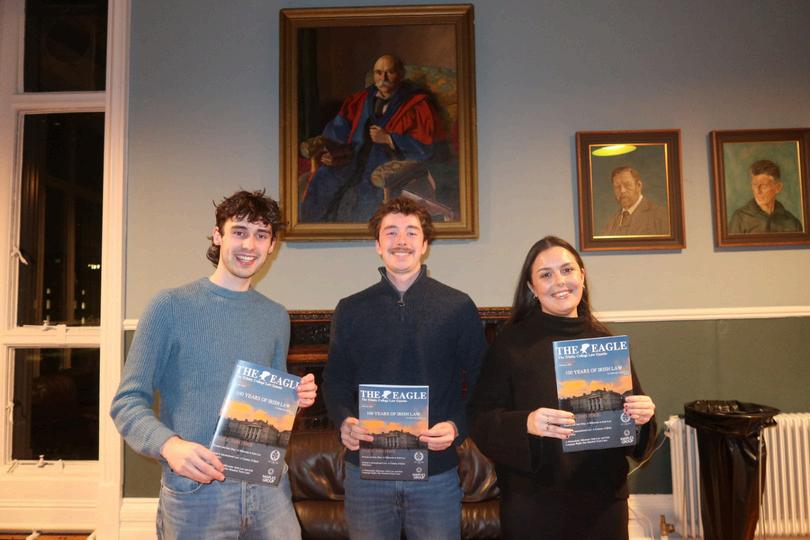
36 | The Eagle Volume 10 Issue 3


This year marked the 10th anniversary of The Eagle: Trinity College Law Gazette, and an impressive year it was. During Michaelmas semester, we launched our first annual issue and received an impressive array of submissions, many of which tackled complex family law issues. This trend corresponded broadly with the theme of the Issue 1 article competition, which was collaboratively organised with Trinity FLAC It was entitled “Gender Equality in Ireland - Article 41 and Beyond”. Annie Egan, JS Law, won first prize for her brilliant Article, “Article 41.2, the Need for “Care” Beyond the Home”. Louise Cullen, SS Law and Political Science, placed second for her insightful contribution, entitled “Reproductive Autonomy: A Crucial Step on the Path to Gender Equality” The issue also featured impressive analyses from several editorial board members, including Deputy Editor, Jacob Hudson, who wrote about post-pandemic penal reforms in Ireland. Aside from contributing stellar writing and interviews to the gazette this year, Jacob also organised the editorial process of each issue and liaised with sponsors Without his hard work behind the scenes, publication would simply not have been possible.
As Hilary term rolled in, the Eagle continued to promote links between legal student societies on campus. Issue 2 was collaboratively launched with the Trinity College Law Society under the theme, “100 Years of Irish Law” , a nod to the 10th anniversary of the Eagle and the 90th anniversary of Lawsoc As a committee member of both societies, it was a particularly special issue for me. I also had the pleasure of writing for Issue 2. I was admittedly stretching the boundaries of the theme slightly by submitting an article about the international legal system Nevertheless, I found myself published alongside some of the most talented writers among my peers, in what was a truly diverse showcase of their abilities. I was delighted for my fellow Lawsoc committee member, Val Murray, when he was announced as the winner of the Issue 2 article competition for his piece entitled “A Melancholic Milestone: Irish law and Irish Language Rights One Hundred Years Later”
At the Issue 2 launch, held on 22 February 2024, Editor in Chief Doireann Minford and Lawsoc Auditor Eoin Ryan spoke eloquently about the contents of the Issue, thanking the editorial board and the contributors for what was undoubtedly a very
special issue of the Gazette Each page was dappled with blue hues, and showcased an array of beautiful photographs featuring sunsets, thanks to contributing photographer Nathan Moore, SS Law and Political Science. However, it was truly the work ethic and dedication of Doireann that explains the standard of Issue 2 and the entirety of Volume 10 An immense amount of work goes into managing a publication of this scale, and I cannot think of a more capable person to have guided the board through the process, and to do it in her own unique way.
I had the pleasure of managing and editing the Eagle Blog this year Volume 10 saw the blog be converted from a general writing platform to a current affairs publication This change truly revitalised the online presence of the Eagle, a task which would not have been achieved without the vibrant and impactful graphics produced by Public Relations Officer Amy Cox throughout the year. Every week, the blog showcased the talent of the Junior Editorial Board and other contributing writers One highlight was Nazar El Basheir’s insightful analysis of legal developments in the world of Korean pop. Alex Coghlan, SS Law and Political Science, also wrote with depth and precision about a scandal embroiling the Spanish Football Federation following the FIFA Women’s world cup. Michael Gormley, SS Law, contributed a fascinating piece about the SAG-AFTRA Hollywood strikes Some editorial board members even took the initiative of publishing their own themed series of blog posts For example, Aoife Doheny, JS Law, produced a set of Commercial Awareness Articles. Elena Hernandez, SS Law and Political Science, wrote multiple articles analytically discussing and explaining developments in the lead up to the 2024 US Presidential Elections I could not be more proud of the standard of writing produced by each and every board member this year for publication on our own collective platform.
It has been such a joy to work on the Senior Editorial Board of the Gazette alongside my good friends, Doireann, Jacob, and Amy It has been equally nice to get to know the junior editorial board members, who have made our jobs so easy Having worked alongside Aoife, Sarah, and David this year, I can say with certainty that The Eagle is in good hands. I wish the editorial board of Volume 11 all the best, and am envious of your position. Savour your time with The Eagle - If you blink you might miss it
37 | The Eagle Volume 10 Issue 3



































